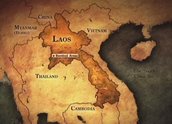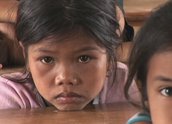


Bomb Harvest (2007)
Synopsis
Bomb Harvest follows Laith Stevens, an Australian bomb disposal specialist training a team in Laos to clear bombs left from the ‘secret war’ the US waged at the time of the Vietnam War. The film also tracks the locals, including children, who scour the countryside for scrap metal to help feed the family. Bomb Harvest depicts the consequences of war, the danger everyone has to face and the bravery of those who are trying to do something about it. The documentary provides the historical context and enormous scope of the tasks at hand but does it in a light-handed, humorous yet moving manner. Bomb Harvest uses observational footage along with interviews, historical war footage and stills.
Curator’s notes
The war in Laos has been an untold story. It was a secret war conducted by the US without the knowledge of the US Congress, the American people or most of the outside world. Any knowledge of the bombing of Laos was eclipsed by the war in Vietnam. Between 1964 and 1973, more bombs fell on Laos than fell in Vietnam and on all the Allied countries in the Second World War put together, which is almost unfathomable to comprehend. Approximately two million tonnes of bombs were dropped in nine years – a half a tonne for every man, woman and child in Laos.
The filmmakers, Kim Mordaunt and Sylvia Wilczynski, spent a year living and working in Vietnam. Wilczynski served as an editor for the Vietnam Investment Review and Mordaunt was writing a script, teaching film and consulting for a Vietnamese film company. While they were living there, they visited neighbouring Laos and fell in love with the landscape and the people. One night in a small town in the mountains of Laos, they went to a bar and happened to meet a couple of bomb disposal technicians. The men told them stories that alerted them to the massive problem of unexploded bombs. These bombs are called UXO or ‘unexploded ordnance’. The bombs litter the country – killing and injuring people (mostly children) continuously.
Laos is poor because the farming land, for more than 35 years, has been contaminated by bombs. In order to survive, the Laotians collect the bomb scrap metal to sell. There is a Communist government in Laos which has media restrictions and it took a year for the filmmakers to obtain the necessary permissions. They were a tight little team, Wilczynski producing and production managing, Mordaunt directing and shooting with Daniel Miau sound recording. As a result, the team were able to film in the field for eight weeks with the bomb disposal team. They felt very privileged as this took them to remote tribal areas which had never been filmed before.
The filmmakers say that the people they met were gentle, warm, funny, witty and resilient. They wanted to make the film entertaining and use the humour of both the locals and the laconic self-deprecating Australian bomb disposal expert, Laith Stevens. Somehow, they are able to find humour in horrific circumstances. Stevens was able to use his humour to bond with the team and local villagers in order to get them through alive.
Bomb Harvest tells an important story. In March 2008 the United Nations Association screened the film to launch a big campaign against the purchase and use of cluster bombs. Just before the 2007 Federal election, Australia had put in a $14 million order for cluster bombs. Excerpts of Bomb Harvest were shown at the International Cluster Munitions Conference in May 2008. At that meeting, 111 countries, including Australia, signed a treaty banning cluster munitions. At a screening in Byron Bay, a local entrepreneur stood up and offered to pay for enough DVDs to be sent to every member of the US Congress. MAG (Mines Advisory Group), the Non-Governmental Organisation that Laith Stevens works for, is providing DVDs of the film to their donors in their own campaign against cluster munitions.
In early 2008, the filmmakers took the film back to Laos for a screening in the capital Vientiane, to open a special visitor’s centre for COPE, which provides prosthetics for victims of bomb accidents. The filmmakers brought the bomb scrap-collecting children up from their village, Savannakhet, to Vientiane for the screening as guests of honour. It was the first time the children had left their village. The filmmakers report that seeing the children’s faces as they walked down the red carpet and saw the images on the big screen was incredibly moving. For most of the Laotians, it was the first time they had seen historical footage of the dropping of these bombs which they see so often in their environment.
Bomb Harvest received a standing ovation at the 2007 Sydney Film Festival and was released in selected cinemas in Sydney, Melbourne, Adelaide, Perth and regional NSW in November 2007. It was nominated for awards by IF, the Film Critics’ Circle of Australia, Australian Directors’ Guild and ATOM. It won Best Music in a Documentary at the 2007 Australian Guild of Screen Composers’ Awards and Best Feature – Children’s Advocacy, at the 2008 Artivist International Film Festival and Awards, Hollywood. A 55-minute version of Bomb Harvest screened on the ABC on 29 November 2007.
- Overview
- Curator’s notes
- Video 3 clips
- Principal credits
- Find a copy
- Make a comment
- Map
- Add your review



